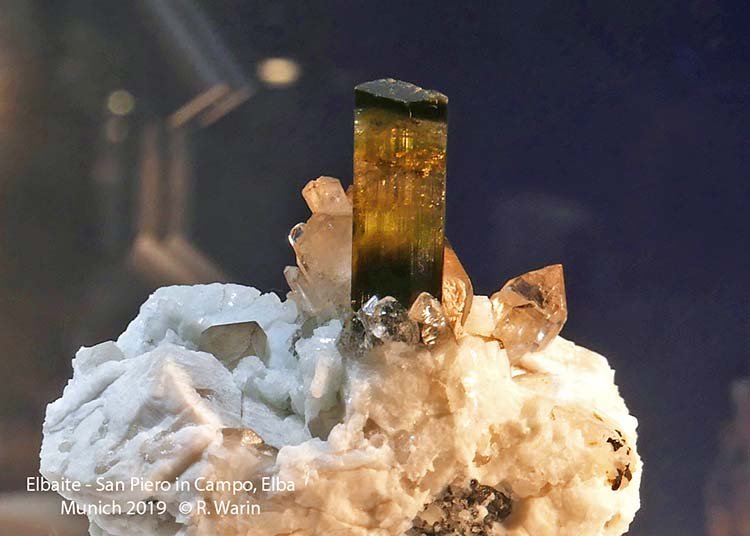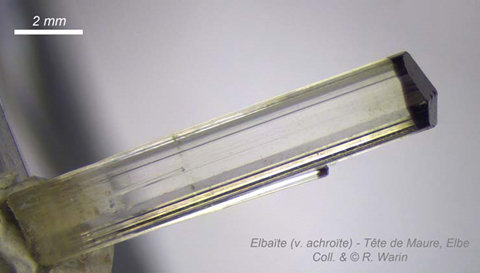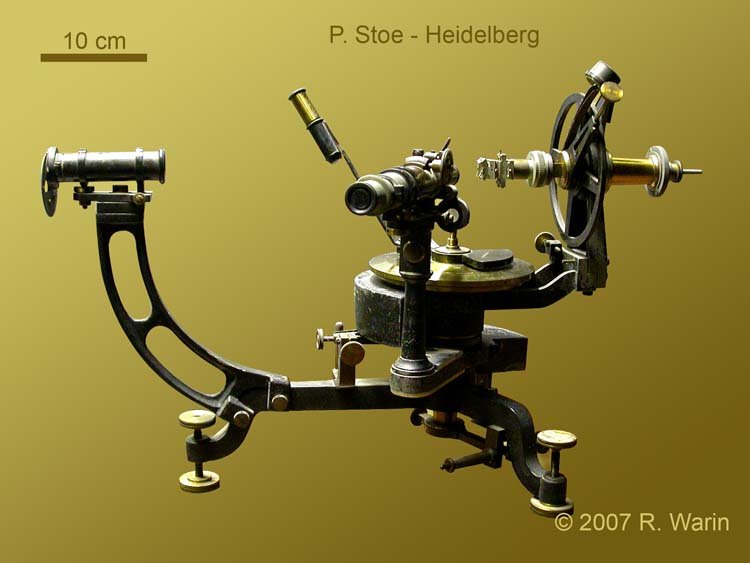| View previous topic :: View next topic |
| Author |
Message |
Roger Warin

Joined: 23 Jan 2013
Posts: 1243



|
 Posted: Apr 19, 2022 04:28 Post subject: Elbaite, ending moor's head Posted: Apr 19, 2022 04:28 Post subject: Elbaite, ending moor's head |
|
|
Hello,
The island of Elba is of course the type-locality of elbaite.
It still often happens that its top is black or very dark brown in color.
In France, this ending is called "Tête de Maure", ie. moor's head.
These are impurities which slip into the lattice at the end of crystallization.
When the elbaite is completely colorless (achroite variety) it is amazing.
What are they? Iron oxides?
| Mineral: | Elbaite |
| Locality: | | Elba Island, Livorno Province, Tuscany, Italy |  |
|
| Description: |
|
| Viewed: |
11251 Time(s) |

|
| Mineral: | Elbaite |
| Locality: | | Elba Island, Livorno Province, Tuscany, Italy |  |
|
| Description: |
|
| Viewed: |
11244 Time(s) |

|
|
|
| Back to top |
|
 |
Bob Carnein
Joined: 22 Aug 2013
Posts: 355
Location: Florissant, CO



|
 Posted: Apr 19, 2022 09:33 Post subject: Re: Elbaite, ending moor's head Posted: Apr 19, 2022 09:33 Post subject: Re: Elbaite, ending moor's head |
|
|
| This question brings up another, which is why do tourmaline crystals often vary in color along their lengths? One normally thinks that crystals grow outward from a "seed", which explains phantoms (e.g. phantom quartz or fluorite). I would guess that this has been studied and answered, but I don't remember seeing the answer anywhere.
|
|
| Back to top |
|
 |
John S. White
Site Admin

Joined: 04 Sep 2006
Posts: 1298
Location: Stewartstown, Pennsylvania, USA



|
 Posted: Apr 19, 2022 10:49 Post subject: Re: Elbaite, ending moor's head Posted: Apr 19, 2022 10:49 Post subject: Re: Elbaite, ending moor's head |
|
|
A quick answer is that a tourmaline crystal, as it is growing, selectively chooses different elements from what is available to incorporate as it grows. An easy example are the common tourmalines with black at their bases only. This is because they favored iron early on as they began to grow, so they used up all of the iron that is available, causing them to be black at first. I don't know why so many elbaites from Elba have black terminations.
_________________
John S. White
aka Rondinaire |
|
| Back to top |
|
 |
Bob Carnein
Joined: 22 Aug 2013
Posts: 355
Location: Florissant, CO



|
 Posted: Apr 19, 2022 16:22 Post subject: Re: Elbaite, ending moor's head Posted: Apr 19, 2022 16:22 Post subject: Re: Elbaite, ending moor's head |
|
|
| John, I get that, but it doesn't explain why growth seems to be upward (or downward) toward the termination rather than outward, as in a phantom quartz xl. If growth was outward, one would expect to see a particular colored core with a different color on the outside, as in the tourmaline slices one often sees offered by dealers. Most elbaite xls. that I've seen have different colored bases and terminations. It may have something to do with the hemimorphism of tourmaline. (?)
|
|
| Back to top |
|
 |
Daniel Garcia
Joined: 02 May 2022
Posts: 23
Location: Narbonne


|
 Posted: May 13, 2022 13:18 Post subject: Re: Elbaite, ending moor's head Posted: May 13, 2022 13:18 Post subject: Re: Elbaite, ending moor's head |
|
|
| Bob Carnein wrote: | | This question brings up another, which is why do tourmaline crystals often vary in color along their lengths? One normally thinks that crystals grow outward from a "seed", which explains phantoms (e.g. phantom quartz or fluorite). I would guess that this has been studied and answered, but I don't remember seeing the answer anywhere. |
Thats a good question, indeed.
I don't know any published paper on this issue, but I have a comment, and a suggestion.
It is quite common to observe a radial zoning in tourmaline, at least in thin section, hence the longitudal one is not the rule.
Concerning a possible mechanism to get a longitudinal zoning in macrocrysts, it seems difficult to advocate unidirectional growth along the c axis, because this would require the crystal to grow first on the transverse direction.
One suggestion is that the crystal may grow normally in 3D with a primary zoning, then diffusion works in the crystal and the impurities (or the vacancies, or whaterver gives the color) diffuse. Diffusion needs time and is severely limited by distances, but If for any crystallographic reason diffusion is allowed to work in the transverse direction, where the distances are shorter, the apparent zoning will change from 3D (normal) to 1D (longitudinal).
|
|
| Back to top |
|
 |
Johan Kjellman

Joined: 10 Jan 2014
Posts: 19
Location: Uppsala


|
 Posted: Jun 10, 2022 15:34 Post subject: Re: Elbaite, ending moor's head Posted: Jun 10, 2022 15:34 Post subject: Re: Elbaite, ending moor's head |
|
|
Federico Pezzotta has at least touched upon similar questions.
Two titles of his:
Color anomalies at the termination of pegmatitic gem-tourmaline crystals from Elba Island (Tyrrhenian Sea, Italy): a genetic model. conference paper 2021
Internal structures, parageneses and classification of the miarolitic (Li-bearing) complex pegmatites of Elba Island (Italy) 2000
His work is available at researchgate.
cheers
|
|
| Back to top |
|
 |
Roger Warin

Joined: 23 Jan 2013
Posts: 1243



|
 Posted: Jun 11, 2022 04:27 Post subject: Re: Elbaite, ending moor's head Posted: Jun 11, 2022 04:27 Post subject: Re: Elbaite, ending moor's head |
|
|
Thanks a lot Johan,
The reference looks good.
I tried to create a ResearchGate account.
The interrogation is military. I had to prove that I was the author of my publications, the first of which dates from 1960.
I have about 150 publications in radiochemistry, chemistry of natural substances, organometallic chemistry and macromolecular chemistry, with also the specialty in Nuclear Magnetic Resonance.
It is the result of a professional life at ULiege. I am currently a mineralogy consultant at ULiege.
I couldn't open the Researchgate account because I don't know any colleagues who have this account.
Is it forbidden for a young 88-year-old researcher to understand the black termination of the elbaites which appear at the base but also at the top of the crystal, being then well defined. In the case of the achroites, the contrast is remarkable.
Roger.
PS: As a password, I place the photo of a goniometer, which Johan will recognize.
| Description: |
|
| Viewed: |
10517 Time(s) |

|
|
|
| Back to top |
|
 |
Johan Kjellman

Joined: 10 Jan 2014
Posts: 19
Location: Uppsala


|
 Posted: Jun 11, 2022 10:40 Post subject: Re: Elbaite, ending moor's head Posted: Jun 11, 2022 10:40 Post subject: Re: Elbaite, ending moor's head |
|
|
Roger,
I hate this, especially those sites where one registered say 5 years ago in order to see or get something, and then come back say 5 years later and try to register (cause one's completely forgotten), and the site responds "sorry there is already a person here by that name...;-)
Concerning the black ends on tourmaline if I recall rightly, initially they are black when the forming pegmatite is close to the Mg-Fe-bearing host-rock, then it wanes as the crystal grows. Then for pressure reasons the pocket erupts and the fluids, because of this, equilibrates a second time with Mg-F-bearing host-rock, hence the dark heads.
cheers
|
|
| Back to top |
|
 |
Roger Warin

Joined: 23 Jan 2013
Posts: 1243



|
 Posted: Jun 11, 2022 16:16 Post subject: Re: Elbaite, ending moor's head Posted: Jun 11, 2022 16:16 Post subject: Re: Elbaite, ending moor's head |
|
|
John,
I dont share this point of view.
The Moor's head is typically at the top of the crystal.
In addition, the origin of the cations which compensate for the negative charges of the stacking of the anionic cyclosilicate rings come from the hydrothermal environment and not from the support rock.
It is true that the Elba deposit is rich in iron. Specimens of pyrite and hematite are famous there.
Thanks for your help.
Roger.
|
|
| Back to top |
|
 |
Johan Kjellman

Joined: 10 Jan 2014
Posts: 19
Location: Uppsala


|
 Posted: Jun 11, 2022 18:31 Post subject: Re: Elbaite, ending moor's head Posted: Jun 11, 2022 18:31 Post subject: Re: Elbaite, ending moor's head |
|
|
Roger,
I think we can agree that the Moor's head signifies an abrupt change in fluid chemistry. A proposed explanation for that abrupt change has been that the pegmatite/pegmatite pocket cracks open and that the fluids then are in contact with host rocks and able to take up elements responsible for the darker phase.
I am not at all referring to Elba iron mines which are not associated with the pegmatites.
cheers
|
|
| Back to top |
|
 |
|





